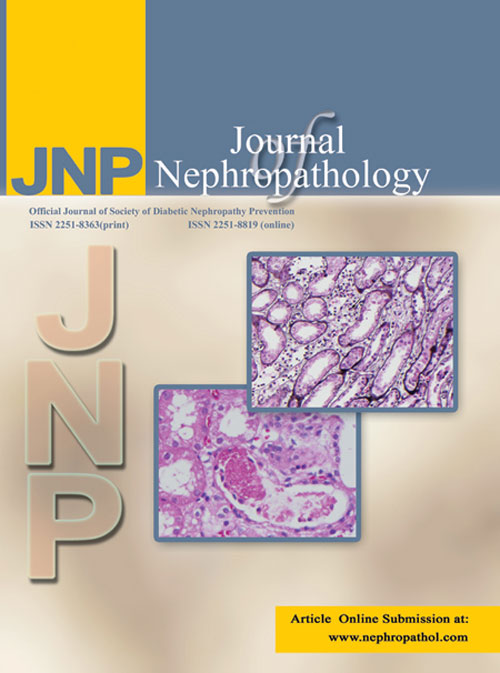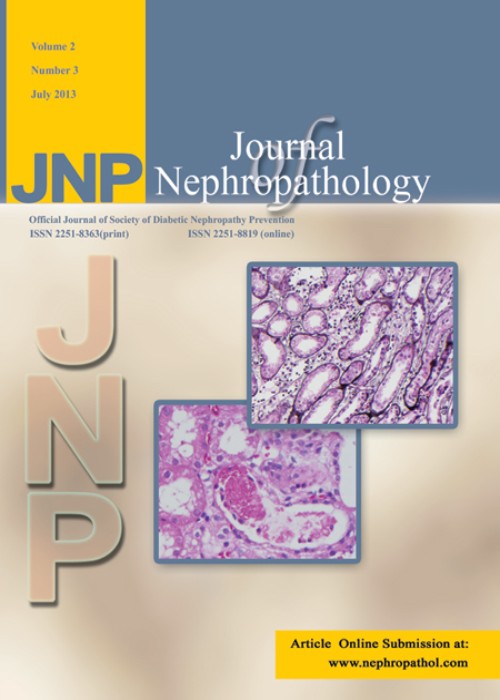فهرست مطالب

Journal of nephropathology
Volume:4 Issue: 1, Jan 2015
- تاریخ انتشار: 1393/12/20
- تعداد عناوین: 6
-
Pages 1-5Context: IgA nephropathy (IgAN) is an autoimmune disorder and is the most common form of primary glomerulonephritis (GN) worldwide. Evidence Acquisitions: Directory of Open Access Journals (DOAJ), Google Scholar, PubMed (NLM), LISTA (EBSCO) and Web of Science have been searched.ResultsIt is a slowly progressing disorder that leads to end-stage renal disease (ESRD) in up to 50% of the patients within 25 years of the onset of the disease. IgAN is defined by predominant IgA deposition in the mesangial area on immunofluorescence (IF) microscopy. Its histology varies from mild focal segmental proliferation of mesangial cells to severe diffuse global proliferation with extracapillary proliferation (crescent formation). The Oxford classification, designed in 2009, is a new classification for the evaluation of morphologic lesions of IgAN. This classification, containing four pathology variables, was found to have prognostic implications. The variables included are mesangial hypercellularity (M), endocapillary proliferation (E), segmental glomerulosclerosis (S) and the proportion of interstitial fibrosis and tubular atrophy (T). However, crescents were not included in the Oxford classification.ConclusionsIn this mini-review, we describe the recent publications about the significance of extracapillary proliferation in IgAN and we conclude that, there is much controversy about the role of extracapillary proliferation as a significant prognostic factor in IgAN. Hence, it is important to re-consider crescents in IgAN patients. Therefore, we suggest further investigations on this aspect of IgAN disease.Keywords: IgA nephropathy, Oxford classification, Extracapillary proliferation, Crescents, End, stage renal disease
-
Pages 7-12BackgroundRenal amyloidosis is one of the main differential diagnoses in the investigation of nephrotic proteinuria in adults, especially elderly patients.ObjectivesThe aim of this article is to contribute to international research with epidemiologic data of renal amyloidosis, given the lack of uniformity described in the literature. Patients andMethodsA retrospective study of 37 cases of renal amyloidosis diagnosed by kidney biopsy, between 2000 and 2011, considering epidemiological, clinical and laboratory data.ResultsSubjects aged between 32 and 80 years. Of the 37 cases, 21 (56.8%) were diagnosed as non-light chain (non-AL) renal amyloidosis and 16 (43.2%) as light chain amyloidosis (AL). There was seen an increase in number of both AL and non-AL cases, with a slight predominance in non-AL. The mean 24-hour proteinuria was 5839.0 mg/day. Hematuria was present in 75% of patients. Hypertension was reported in 34% of patients. Acute renal failure, occurred in about 10% of patients, and chronic loss of renal function was present in about 5% at diagnosis.ConclusionsRenal amyloidosis is a disease of increasing incidence. The forms of clinical presentation proved to be variable, but the presence of proteinuria or nephrotic syndrome in elderly patients should always prompt the suspicion of renal amyloidosis and is a formal indication of renal biopsy.Keywords: Amyloidosis, Proteinuria, Kidney biopsy, Nephrotic syndrome
-
Pages 13-17BackgroundVarious strategies have been applied to improve the response to hepatitis B virus (HBV) vaccination in hemodialysis patients.ObjectivesThe present study was under taken to compare the seroconversion rate of hemodialysis patients who had not respond to 3 intramuscular (IM) doses (40 μg each) of HBV vaccine, after a fourth IM dose (40 μg) of HBV vaccine that was administered alone or with subcutaneous granulocyte-colony stimulating factor (G-CSF) (5 μg/kg). Patients andMethodsTwenty six hemodialysis patients who had not responded to 3 IM injections of HBV vaccine were randomized into 2 groups: Group 1 received a booster dose of 40 μg HBV vaccine IM, group 2 received a booster dose of 40 μg HBV vaccine IM plus 5 μg/kg subcutaneous G-CSF. Antibody to hepatitis B surface antigen was measured 1 month after the booster dose.ResultsSeroconversion rate in group 1 was 40%. There was a trend towards a higher seroconversion rate at 60% in group 2 patients; however, because of the small number of patients it did not reach statistical significance.ConclusionsLarger number of patients and other innovative strategies should be applied for vaccination of this group of patients. More prolonged follow up of the patients is needed to evaluate the duration of protection induced by each method of vaccination.Keywords: Granulocyte, colony stimulating factor, Hemodialysis, Vaccination, Hepatitis B, Granulocyte, macrophage colonystimulating
-
Pages 19-23BackgroundIgA nephropathy (IgAN) is the most prevalent primary chronic glomerulopathy worldwide. Thus, it is of vital importance to search for factors aggravating the disease progress, monitor disease activity and predict disease-specific therapy. C4d is a well-known biomarker of the complement cascade with a potential to meet the above needs.ObjectivesThe aim of our study was, therefore, to determine whether C4d staining at the time of kidney biopsy had any correlation with the demographic, clinical and biochemical variables in IgAN. Patients andMethodsThe definition of IgAN requires the presence of diffuse and global IgA deposits which were graded ≥2+ and weak C1q deposition. C4d immunohistochemical staining was conducted retrospectively on 29 renal biopsies of patients with IgAN, which were selected randomly from all biopsies. C4d immunohistochemical staining was performed on 3-μm deparaffinized and rehydrated sections of formaldehyde-fixed, paraffin-embedded renal tissues.ResultsOf 29 selected patients, 68% were male. In this study, 54.2±25 percent of glomeruli in all biopsies were positive for C4d. The mean and standard deviation (SD) of serum creatinine and the magnitude of proteinuria were 1.72±1.2 mg/dl and 1582±1214 mg/day, respectively. In this study, we observed statistically significant correlations of percent C4d positivity with the serum creatinine (r=0.61, p=0.0005), magnitude of proteinuria (r=0.72, p=0.0001), the proportion of globally sclerotic glomeruli (r=0.43, p=0.02) and the proportion of tubulointerstitial fibrosis (r=0.54, p=0.0023).ConclusionsThe results from our investigation on C4d positivity in biopsy-proven cases of IgAN are in accord with some of the previous studies. These findings, however, require further validation in larger samples.Keywords: C4d, Complement, Glomerulopathy, IgA nephropathy, Immunohistochemistry
-
Pages 25-28BackgroundLecithin cholesterol acyltransferase (LCAT) is an important enzyme in cholesterol metabolism that is involved in the esterification of cholesterol. A lack of this enzyme results in deranged metabolic pathways that are not completely understood, resulting in abnormal deposition of lipids in several organs. Clinically, it manifests with proteinuria, dyslipidemia and corneal opacity with progressive chronic kidney disease resulting in end-stage renal disease.Case PresentationWe herein present a case of a 30-year-old male with proteinuria that was not responsive to empiric management with angiotensin-converting enzyme (ACE) inhibitors and oral steroids. Physical examination revealed corneal ring opacity involving both eyes. Urinalysis revealed an active sediment. The 24-h proteinuria was 3.55 grams. Family history was positive for renal disease and dyslipidemia. Viral serology for human immunodeficiency virus (HIV), hepatitis C virus (HCV) and hepatitis B virus (HBV) were negative. Serum complements were normal and anti-nuclear antibody (ANA) was negative. We elected for a renal biopsy that revealed characteristic features of LCAT deficiency. The diagnosis of LCAT deficiency was established with a combination of clinical and pathological findings.ConclusionsCurrently renal prognosis is poor but conservative management with ACE inhibitors and lipid lowering therapy in addition to steroids has been shown to retard progression to end-stage renal disease. However newer therapies such as gene replacement and recombinant LCAT replacement are being studied with promising preliminary results.Keywords: Familial lecithin, cholesterol acyltransferase (LCA, Proteinuria, HDL, cholesterol
-
Pages 29-31BackgroundFluoroquinolones are known to cause acute renal failure due to interstitial nephritis.Case PresentationHere we present an elderly woman who developed oliguric acute kidney injury (AKI) after receiving oral and intravenous ciprofloxacin in a 48-hour period. Recently, several case reports have been published in the literature regarding the presence of crystals in the urine sediment of patients treated with ciprofloxacin for different types of systemic infections. Ciprofloxacin crystals precipitate in alkaline urine and provoke renal failure through intra-tubular precipitation.ConclusionsConservative measures including intravenous hydration and avoidance of alkalinization of the urine can reverse this condition if applied in time.Keywords: Acute kidney injury, Interstitial nephritis, Fluoroquinolones, Crystalluria


